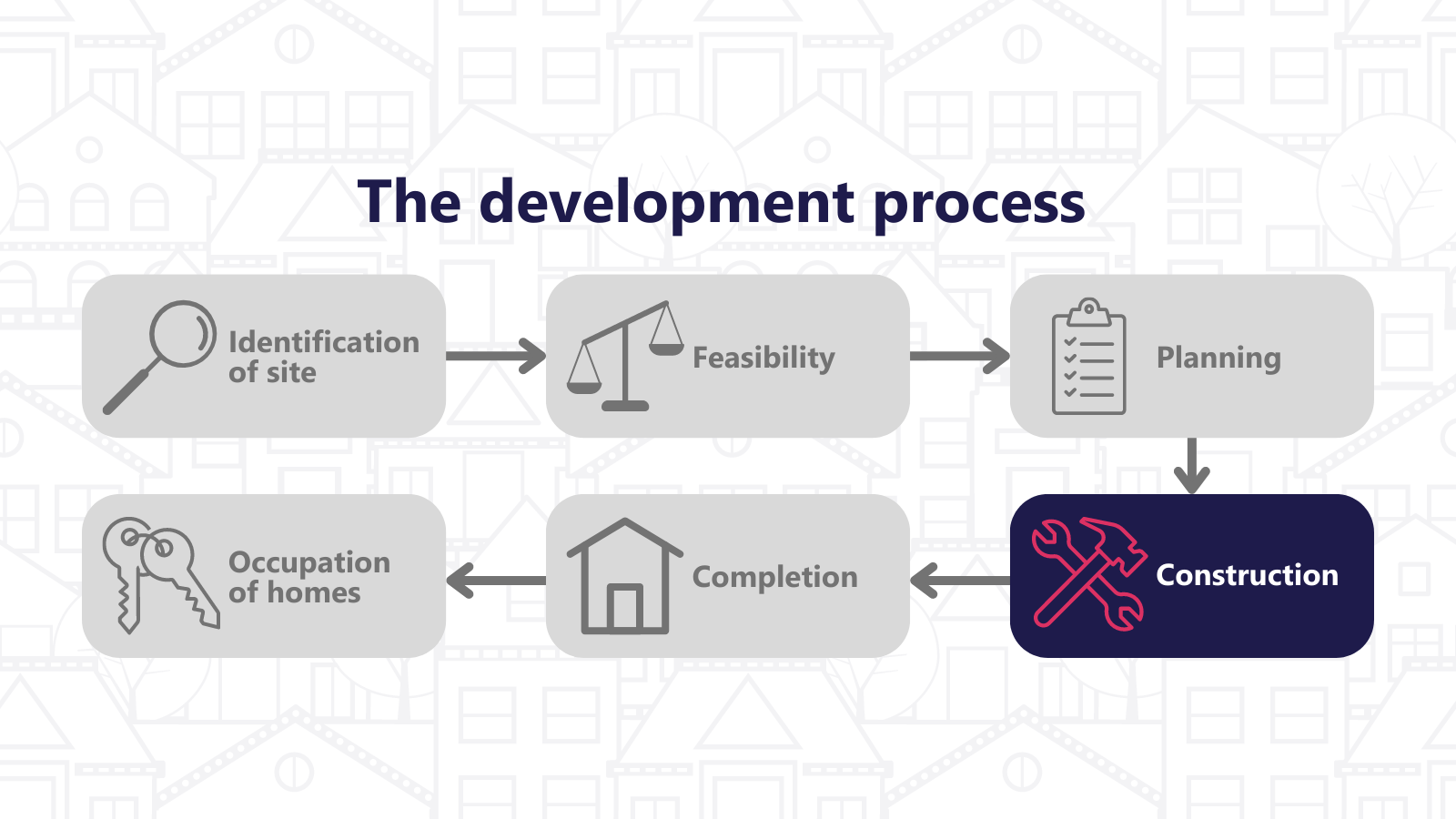Construction


Having successfully obtained planning permission and SAB approval, the purchase of the site or property acquisition can be completed, and consideration turned to the procurement of construction works. CLH development schemes will have a variety of approaches to the build phase including self-build, self-finish, sweat equity schemes or contracted works. However, to a lesser or greater degree each of the approaches will require some or all of the building works to be undertaken by external contractors.
When beginning to think about procuring building works and the services of external contractors, there are a number of factors to consider around contractor selection, contractor management, how to build the new homes and the form of contract or procurement route to be used. These factors and considerations may be summarised as:
• Capability and track record of contractors
• Understanding of CLH
• Capacity to undertake works
• Health and Safety management
• Value for money
• Programming
• Quality control
• Financial standing and status
• Procurement policies and regulations
• Modern Methods of Construction (MMC) and Off-Site Manufacture (OSM)
• Contribution to local supply chains
• Procurement routes – Design & Build or Traditional
Many of these factors are set in the context of the client aspirations and attitudes towards risk, cost certainty, control over design development and ensuring that the essence of the scheme concept and proposals remain in terms of quality control.
In most instances, the procurement of works will require that the building works are subject to some form of tendering process and exercise. This is likely to be a requirement of funders and the internal governance arrangements of the client, though there are variations to the tendering process that can still achieve the necessary degree of competition and transparency.
There are few steps in the process which include:
• Compile tender documents – plans and drawings, specifications and conditions of contract, all of which are collated into an Employers Requirements Document
• Routes – negotiated or competitive tenders
• Tender return procedure – dates, format, supporting information
• Cost and quality balance – it might be a preference for the client to award the building contract based on a suitable combination of the tender cost and a qualitative submission around the approach to the work, community benefits and proven track record. This might result in the overall tender being accepted not being the lowest price tender. This is the so-called MEAT or Most Economically Advantageous Tender which combines cost and quality to determine the final contractor selection and will need to be stated in the tender invitation process and confirmed as acceptable to potential funders
Aside from the administrative exercise of collating tender documents and initiating a tender exercise, there are some further considerations that need to be made around the tender process including:
• Procurement regulations – both internal client and external funder requirements
• Time – allowing sufficient time to prepare documents and for the tender period itself to ensure pricing is robust
• Number of contractors to be invited to tender
• Cost and resources to both client and tendering contractors
• Nature and complexity of the scheme
• Funder requirements
Whether tenders are returned in an electronic format or written paper returns, it will be necessary to ensure that during the tender period all contractor queries are responded to promptly and that information is communicated openly and transparently. This includes technical queries and if the client is minded to extend the tender period. In addition, in whichever format tenders are returned, the submissions should be recoded with the time and date and retained securely and unopened until after the deadline for tender returns has passed. Arrangements should be put in place in advance to open the tenders promptly after the return deadline in accordance with the client governance requirements and that any tenders received after the deadline are disqualified.
Upon opening of tenders there follows a process of tender assessment, review, approval and acceptance which includes consideration of the following with the aim of arriving at a ‘preferred tender’ status which can be taken forward for approvals and awarding of the building contract:
• Tender assessment – accuracy, arithmetic checks, completeness, comparison
• Qualifications to tender
• Contractor status and capacity
• Programming and mobilisation
• Health and Safety documentation
• Post-tender negotiation (if necessary)
• Compilation of a tender report
• Revisit financial viability model with tenders returned
• Approvals – funders, internal governance
It is at this point of award of the building where the pre-contract stage of the development process ends and the post-contract stage commences.
The award of a building contract is a key point in drawing together all the activities within the pre-contract culminating in the procurement of the construction works through a tender process and the final commitment to begin the build phase. This is the same series of events and activities irrespective of whether the CLH scheme is a new-build construction or refurbishment of an existing building.
The key feature of a building contract is that it formalises the arrangements and relationship between the client or employer and the contractor in terms of the ‘what, when and how’ of the build phase as well as setting out the terms and conditions for undertaking building works, and if necessary, the mechanisms for dispute resolution. Some of the key components of the building contract include:
• Define parties to the contract
• Basis of payment for works through interim staged payments on a monthly basis
• Define works duration or contract period
• Conditions of contract – penalty clauses, insurances, performance bonds, retentions, rectification or defects management, dispute resolution, variations to time and cost
• Scheme drawings and specifications
• Employers Requirement Document
• Use of Standard Forms of Contract, e.g. JCT With Amendments
As part of the award of contract, there is a formal pre-commencement meeting which takes place between the parties to the building contract. It has a formal set of agenda items where documentation is exchanged, day-to-day operational arrangements confirmed, contractor mobilisation begins and any queries addressed as well as establishing the diary of progress meetings during the works period, usually on a monthly basis. Finally, it is at this meeting that the parties will formally sign and execute the building contract.
Some of the items covered in the pre-commencement meeting include:
• Agreed site possession, works commencement and completion dates
• Master Programme
• Contractor Cash Flow Forecast
• Monthly site progress meetings and communications
• Interim payment arrangements
• Insurances and bonds
• Warranties provided from designers
• Site supervision and management key personnel
• Information required by contractor from the client
• Community benefits plan
• Local community and neighbourhood communication
• Site security and emergency contact details
• Health and Safety including HSE F10 notifications
• Discharge of pre-commencement planning conditions and building regulations
At the construction stage, within the works programme there are a series of substages or works packages which are worked through to the point of completion of the building works. These are summarised thus:
• Site clearance and preparation
• Substructures
• Superstructure
• Services
• Heating and electrical installations
• Fixtures and fittings
• External works
• Finishes
• Commissioning
Again, these will vary according to whether the works are new-build or refurbishment, but each will be underpinned by site and contractor management processes and protocols related to Health and Safety, programming and scheduling, cost management and quality control.
Inevitably, during the works period there will be variations whether planned on the part of client requests or unplanned due to unforeseen works. In this regard, it is important that there are suitable measures and processes in place to monitor variations and to ensure that sign offs, approvals and consents are in place for these variations and to ensure that other approvals and sign offs are in place around statutory, legal and financial requirements.
These include:
• Client
• Contract Administrator/Project Manager
• Building Regulations
• Structural Warranty Insurance, e.g. NHBC, LABC
• Highways and drainage adoption
• Discharge of planning conditions
• Health and Safety












